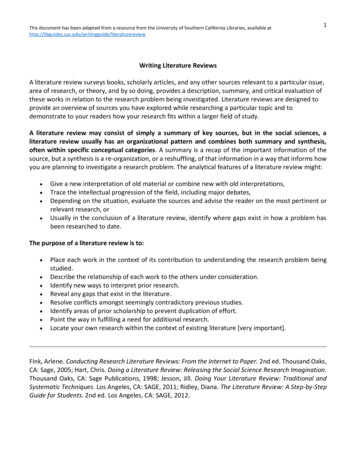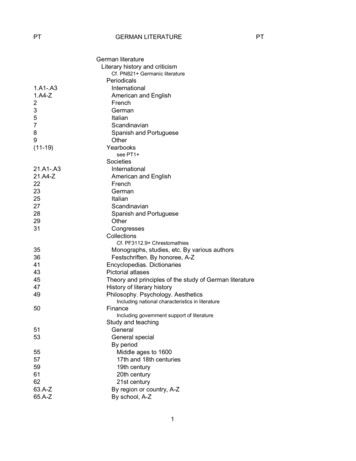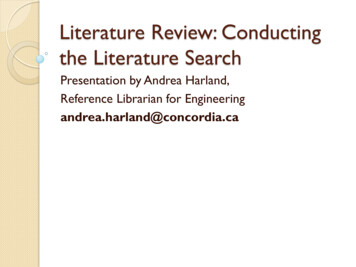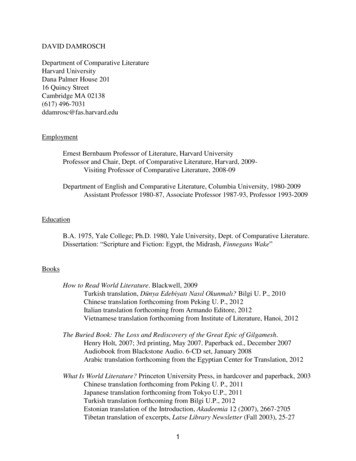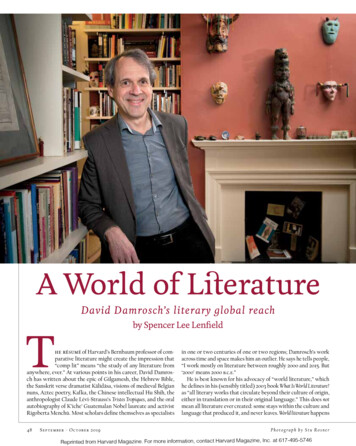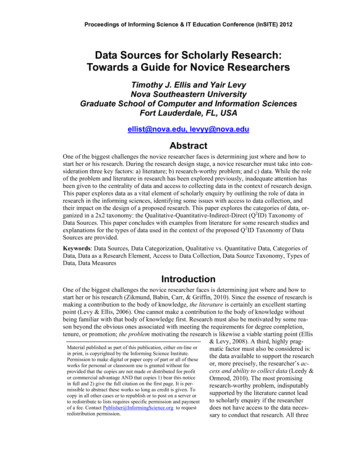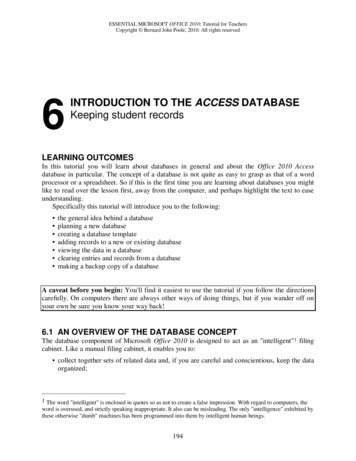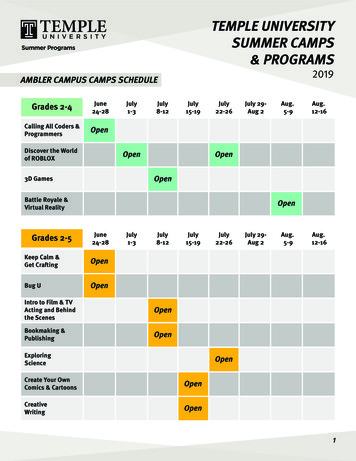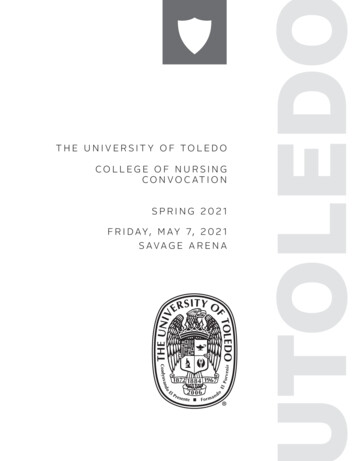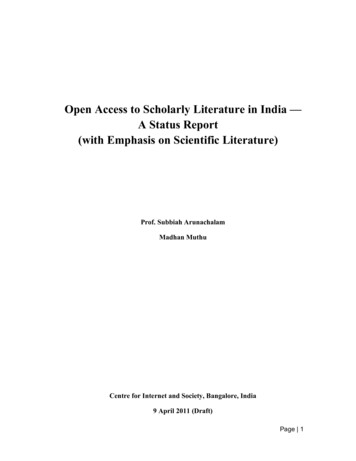
Transcription
Open Access to Scholarly Literature in India —A Status Report(with Emphasis on Scientific Literature)Prof. Subbiah ArunachalamMadhan MuthuCentre for Internet and Society, Bangalore, India9 April 2011 (Draft)Page 1
Table of ContentsChapter 1: Scholarly Communication . 4Introduction . 4Scholarly Communication . 4Scholarly Communication and Evaluation of Science . 8Chapter 2: Science in India . 12Structure and Organization of Science in India. 12Changing face of Indian Science . 13Chapter 3: Open Access . 16What is Open Access? . 16Why Open Access?. 17Chapter 4: Open Access in India. 24Box 1, Vidhanidhi (Electronic Theses and Dissertations). 25The Evolution of open access in India. 27Box 2, Medknow Publications – An Innovative open access Journal Publisher. 28Box 3, EPrints@IISc – The First Indian Institutional Repository. 30Box 4, Open Access Versions of Indian Medical Journals hosted by Indian MedlarsCentre, NIC . 33Box 5, Mandating Open Access in an International Research Organization: TheICRISAT Story. 34Box 6, Open J-Gate: India’s Contribution to Open Access Movement . 37Box 7, Workshop on Electronic Publishing and Open Access Indian Institute ofScience, Bangalore, 2-3 November 2006 [Supported by the Open Society Institute] . 40Box 8, CSIR’s Effort to Mandate Open Access . 44Open Access Journals. 47Open Access Repositories . 48Page 2
Box 9, Dspace@NITR. 49Box 10, Institutional Repository @NAL. 52Box 11, NIO’s Institutional Repository. 54Chapter 5: Publisher Self-archiving Policies and Author Addenda . 61Self-archiving Policies. 61Copyright Addenda. 61Chapter 6: Mandates. 64Chapter 7: Recommendations . 66Tables . 68Figures. 74Appendices . 83Open Access in India – Timeline . 119Bibliography. 122Open Access: A Bibliography of Papers by Indians on India . 122Page 3
Open Access to Scholarly Literature in India — A Status Report (with Emphasison Scientific Literature)“Knowledge is the common property of mankind.”Thomas Jefferson, third President of the United States“One day open access will be just as natural as breathing we won't need to askanybody's permission.”Prof. Wiljan van den Akker, Dean, Utrecht University“Open access isn't a threat either quite the contrary, it offers tremendous opportunities. It has advantages for all concerned.”Prof Henk Zijm, Dean, University of TwenteChapter 1: Scholarly CommunicationIntroductionNothing that has happened in the recent past can have as great an influence as openaccess on science and scholarship in the developing world, and yet many developingcountries including India are not adopting open access with enthusiasm. Developingcountries remain developing largely because they often let go such opportunities.This report is about open access. However, we will begin with a brief introduction toscholarly communication as open access is all about scholarly communication. We willthen set the context by having a quick look at the status of science in India before we proceed to discuss open access in India.Scholarly CommunicationThe ecology of scientific knowledge productionScience is a truly global and collective endeavour. It is at once a competitive andcooperative enterprise where free and unhindered flow of knowledge is essential for making any advance. A classic example of fierce competition in science was the controversyover the discovery of calculus involving Newton and Leibnitz in the seventeenth century.1 More recent examples include the race between Linus Pauling and Francis Crickand James Watson for the discovery of the structure of DNA in the 1950s2 and the controversy over the discovery of HIV retrovirus involving Luc Montagnier and Robert12Loy J (2002), Newton vs. Leibniz, http://www.jimloy.com/calc/newtleib.htm.Watson J D (1968), The Double Helix, Atheneum, New York.Page 4
Gallo in the 1980s,3 both of which had all the elements of a Hollywood drama. Examplesof collaboration in science include the decade-long effort that led to the mapping of thehuman genome, arguably one of the largest international scientific collaborations everundertaken,4 and the number of South–South and North–South collaborations undertakenever so often in high energy physics at international research facilities such as CERN, theEuropean Organization for Nuclear Research.5 If deciphering the human genome tookthousands of scientists and more than 3 billion, there are also examples at the other extreme of single individuals like the reclusive Russian mathematician Grigory Perelman,who had turned down both the Fields Medal and the Clay Millennium Prize,6 and India'sown Srinivasa Ramanujan,7 both of whom worked virtually in isolation and at no cost tothe exchequer and yet produced world class research. Although such lone rangers arerare, their work will also form part of the universal knowledge pool of science.Scientists build on what is already known. Cooperative or competitive, lone rangersor working as a team, scientists depend to a great extent on the contributions to knowledge made by others across space and time — scientists working in any part of the worldand those who have contributed to science in the past. As Sir Isaac Newton said, “if Ihave seen further it is only by standing on the shoulders of giants.”Information is the key to science development. It helps scientists and scholars notonly advance knowledge but also their own professional status. In science, information isa two-way street: scientists make the new information they generate available to as manyof their peers as possible, and seek and obtain as quickly as possible the information generated by other researchers that is relevant to their own research.Down the centuries, since scholarly communication is said to have begun in ancientGreece more than 2,000 years ago, research has typically been communicated in parallelby speech and writing.8 However, since the beginning of modern research in WesternEurope during the sixteenth and seventeenth centuries flow of information is facilitatedlargely by professional journals. In those early days science was known as natural philosophy! Ever since the first professional journals — Journal des Sçavans in France andthe Philosophical Transactions of the Royal Society in England — commenced publica345678Bazell R (2008), Dispute behind Nobel Prize for HIV research: French researchers win for virus discovery; controversial scientist shunned. nd opinion.Human Genome Project Human Genome/home.shtml.Kroes N (2010), CERN.fascinating insight into scientific es/tag/cern-eu/.Gessen M (2010), Perfect Rigor: A Genius and the Mathematical Breakthrough of the Century , Houghton Mifflin Harcourt, Boston.Kanigel R (1991), The Man who Knew Infinity: A Life of the Genius Ramanujan, Scribner, New York.Meadows A J (1997), Communicating Research, Academic Press, San Diego.Page 5
tion in 1665, the printed journal has become the primary vehicle of knowledge dissemination among scientists and scholars. (The field of computer science, where conferences arepreferred, is an exception.) Scientists also meet other scientists, present papers at conferences, and write reports, monographs, textbooks, etc. But journals occupy a special placein scholarly communication, not only because they help scientists get the status of a permanent record for their new findings but also to establish ‘priority’, something scientistsguard jealously. Papers are given away for free and scientists do not normally get paid forreporting their research in journals or for reviewing papers received from journal editorsbefore they are published, whereas publishers pay them for writing textbooks and monographs.What are journals? They are nothing but a collection of articles written by differentauthors appearing periodically. They provide a platform for researchers in a field, sometimes very narrow (e.g. Journal of Raman Spectroscopy, Annals of Maxillofacial Surgery) and at others all embracing (Lancet covering all of medicine, and Current Science,Nature and Science covering all of science), to announce their latest findings to other scientists around the world. In the early days there were a few scientists and a few journals,but in the past three centuries the number of scientists has increased exponentially. Sincethe early 1700s, the number of scholars in scientific disciplines has doubled every 15years, according to de Solla Price.9 And the questions they ask and the experiments theyperform have become more complex and have led to the evolution of new fields, subfields and research fronts which in turn have led to the emergence of a large number ofprofessional societies and specialty journals. Obviously, there will be hundreds of thousands of articles published every year and even larger number of references to earlier articles as it is an accepted convention to acknowledge ‘the shoulders of giants’.Journal editors do not accept for publication all manuscripts they receive. They getthem reviewed by other scientists with expertise in the field and this process is calledpeer review. Some manuscripts are recommended straightaway, some are found not goodenough for publication and many are returned to authors with comments and suggestionsfor revision. “Peer review results in 1.3 million learned articles being published each yearand it is fundamental to the integration of new research findings in hundreds of fields ofinquiry and represents a unique, global collaboration in evaluation and quality assurance,” says the International Association of Scientific, Technical & Medical Publishers(STM).10In the past more than 340 years, the scholarly journal has not changed much. Nodoubt there have been changes both in the way the content is presented and in the way910de Solla Price D J (1963), Little Science, Big Science, Columbia University Press, New York.Peer Review Survey 2009: Preliminary Findings (2009), Sense about php/site/project/395.Page 6
journals are produced. The leisurely prose of people like Oldenburg and Faraday hasgiven way to the terse, almost cryptic, language of today’s science journals where mostexperimental details are replaced by a superscript or a footnote (reference to an earlierpaper). Certainly the papers do not begin with ‘Dear Sir’ as it did in the early years! Today’s journals are no longer printed using the movable type invented by Guttenberg butuse computer-composed text. And many of them have gone online. Today's journalscarry a variety of papers such as full-length original research papers, short communications, review articles and letters.As knowledge in a given area started growing fast, it became difficult for most practitioners to keep pace with developments. That led to two different developments, one atthe cognitive level and the other at the level of packaging information.At the cognitive level, to be able to manage knowledge growing at a fast pace scientists divided fields into subfields and further into narrower specialties. For example,chemistry was organized into physical chemistry, organic chemistry, inorganic chemistry,nuclear chemistry, etc., and in turn organic chemists started specializing in heterocycliccompounds, steroids, physical organic chemistry, synthetic organic chemistry, naturalproducts chemistry, etc. However, all of scientific knowledge is a single whole with different fields and subfields related to each other, some are close and others are distant. Theunity of sciences is revealed beautifully in the diagram ‘Scientific paradigms’. [See Appendix 1] This notion of the unity of sciences is central to science. We now see scientistsoriginally trained in physics or engineering working on biological problems of great importance or working as economists in the World Bank and hedge fund managers in WallStreet. Also, areas such as complexity science and nanotechnology attract bright mindsfrom all fields.At the level of packaging knowledge, the emergence of review journals such asChemical Reviews and Annual Review of Microbiology, abstracting services such asChemical Abstracts (now SciFinder Scholar), current awareness services such as CurrentContents, and multidisciplinary citation indices such as Science Citation Index (now partof Web of Science) helped overcome the problem of dealing with the unmanageablegrowth of knowledge to some extent.With the rising number of journals, academies and societies which were traditionallypublishing them could no longer cope with the numbers. And enterprising commercialpublishers started taking over the burden of publishing many of the journals. That pavedthe way for privatization of knowledge. Today there are reportedly 25,000 refereed journals in the areas of science, technology and medicine (STM), many of them published bycommercial publishers. As of late 2010, Elsevier published 1610 journals, Springer 588Page 7
journals and Lippincott Williams & Wilkins 299 journals.11 According to a 2009 report,“The scholarly journal marketplace has consolidated in recent years. Three companiesdominate: Elsevier, Springer, and Wiley. Elsevier is the dominant force in science, technology, and medical (STM) publishing, with three times the market share of its closestcompetitor. Commercial publishers have established considerable monopoly power, playing a role in 60 per cent of all peer-reviewed journals, owning 45 per cent and publishing17 per cent on behalf of non-profit organizations. In STM, seven major commercial publishers account for 30 per cent of peer-reviewed titles but 60 per cent of the market’srevenue.” 12With the advent of new technologies such as the Internet and the World Wide Web, itbecame possible for scientists around the world to look for alternatives to journals. Forexample, in 1991 Paul Ginsparg of Los Alamos National Laboratory (LANL) came upwith arXiv, an electronic preprint service for the physics community.13 Although therehad been preprint services for physicists earlier, such as the ones at the Centre for Research in Nuclear Energy, Geneva (CERN) and Stanford Linear Accelerator laboratory(SLAC), it was arXiv which really revolutionized sharing of information among physicists in a fully online manner.With dwindling budgets and rising costs of journals, scholarly communication todayis at a crossroads. We need to think seriously about how scholarly information can beshared efficiently and at an affordable cost. Even librarians in affluent institutions in theUnited States feel that current methods of scholarly communication are unsustainable andproving to be excessively restrictive.Scholarly Communication and Evaluation of ScienceWhile the main purpose of scholarly communication is, as the very name indicates,communicating results of scientific research among scientists and scholars, it has acquired an additional function, viz. evaluation of scientific research. Research is done byresearchers not only for uptake by other researchers but also for the benefit of the publicthat funds the research. What is more, the research uptake not only contributes to researchprogress but also to one's own career advancement, recognition by way o of rewards andfunding. This aspect of scholarly communication takes advantage of the networked nature of scientific papers — later papers citing earlier papers and several papers quotingthe same paper.111213Koehlmoos TP and Smith R (2011), Big Publishers Cut Access to Journals in Poor Countries, The Lancet, 377: 273 -276. DOI: 10.1016/S0140-6736(11)60067-6.Young P (2009), Serials Crisis and Open Access: A White Paper for the Virginia Tech Commission onResearch; http://scholar.lib.vt.edu/faculty archives/YoungP/OAwhitepaper.pdf.Ginsparg P (2001), Creating a Global Knowledge Network, Second Joint ICSU Press — UNESCO Expert Conference on Electronic Publishing in Science;http://people.ccmr.cornell.edu/ ginsparg/blurb/pg01unesco.html.Page 8
In the 1950s, Eugene Garfield, an intrepid scholar-entrepreneur, saw the possibility ofusing the links between the articles and the cited references to construct a citationindex and define impact factors for journals (based on how often an article published in ajournal was cited on average in a given period) to measure the importance of differentjournals in their fields.14 The Institute for Scientific Information which he founded (andwhich currently forms part of Thomson Reuters) started bringing out Science CitationIndex (SCI) and providing journal impact factors in the early 1960s.15 Garfield followed itup with a novel application, viz. The indices he developed to studying science.16 Sincethen policy makers and administrators in governments and funding agencies use citationsand impact factors as performance evaluation indicators. For example, the National Science Foundation, USA, uses publication and citation data taken from SCI in its biennialreport Science and Engineering Indicators to assess the status of science in the US andcompare it with the status of science in other countries.17 To give another example, in anarticle published in Nature, Sir David King, the former Chief Scientific Advisor to theGovernment of UK, used publication and citation data to show that eight countries, led bythe USA produced almost 85 per cent of the world’s most highly cited (top 1 per cent)publications between 1993 and 2001 and the top 31 countries accounted for 97.5 per centof most highly cited papers while 162 other countries produced less than 2.5 per cent.18 Arecent Royal Society report19 provides a number of science indicators. Here is a summary by Siemens20:14151617181920 In 2008, the world invested almost 1.2 trillion on research, and there were 7.1million researchers who together authored 1.58 million research publications (ofwhich less than 9 per cent came from social sciences and humanities). The G-8 countries are still leaders in research, but will be overtaken by China inthe near future. In all probability China may overtake the United States as theworld's leading publisher of research papers as early as 2013.Garfield E (1955), Citation Indexes for Science: A New Dimension in Documentation through Association of Ideas, Science, 122: 102-111; 8y1983.pdf.Garfield E (1964), Science Citation Index — A New Dimension in Indexing, Science, 144: 649 – p525y1984.pdf.Garfield E (1970), Citation Indexing for studying science, Nature, 227: 669 – 1p132y1962-73.pdf.National Science Board, (2010). Science and Engineering Indicators 2010. National Science Foundation, Arlington, VA; 6.htm.King, D A (2004), The Scientific Impact of Nations, Nature, 430: 311-316 DOI: 10.1038/430311a.The Royal Society (2011), Knowledge, Networks and Nations: Global Scientific Collaboration in the21st century, RS Policy document 03/11; http://www.ukcds.org.uk/ rks-nations.pdf.Simmons G (2011), Knowledge, Networks and Nations, Elea ment-78747.Page 9
There is a growing need for open access — not only in developing countries, butfor the benefit of science globally. 65 per cent of R&D is funded by private enterprise (up from 52 per cent in 1981)in OECD countries. Developing countries have a greater percentage of government funded research. Collaboration is on the rise — researchers, institutions, and countries are interconnected in their research. Science is happening in more places but it remains concentrated. Therecontinues to be major hubs of scientific production — flagship universities andinstitutes clustered in leading cities. What is changing is that the number of thesehubs is increasing and they are becoming more interconnected. Foundations (Bill & Melinda Gates in particular) are playing an important role onglobal health research, and there are concerns about transparency of foundationsin general.In a recent paper, Madhan et al. have shown that in the ten years 1998 – 2007 therewere less than 800 papers from India that were cited at least 100 times, compared to morethan 9,000 papers from France and Japan.21 This asymmetry between the rich and thepoor countries persists and is not likely to go away soon.Figure 1, taken from Worldmapper shows the severity of the asymmetry in the production of scientific papers graphically. While the United States is bulging, the entirecontinent of Africa, but for publications from South Africa, is all but a thin streak andLatin America is famished too. Please note this figure is based on publication data for2001. If we use data for 2010, both China and India will be looking much larger.Hundreds of literature-based studies are carried out annually on internationalcollaboration among scientists, academia-industry interaction, relevance of research tolocal needs, etc. Scientists are happy when their work is cited by others as oftenincreased citations help in winning fellowships, awards, promotions and research grants.Journal publishers are happy when articles published in their journals are cited as increase in citations leads to increase in impact factors and the journals go up in the pecking order. Indeed, there is intense competition among journals and research institutions topublish more highly cited papers. However, it must be understood that as far as quality ofresearch is concerned peer review is the most accepted yardstick.21Madhan M, Chandrasekar G and Arunachalam S (2010), Highly Cited Papers from India and China,Current Science, 99: 738-749 e 10
Doing science (or working in any other area of scholarly pursuit) in a developingcountry has its own problems. First, the facilities available — funds, laboratories, libraries, infrastructure, opportunities to attend conferences and meet peers — are meagre.Second, there is an inherent bias among many scientists in the developed countries aboutthe capabilities of scientists from the developing countries. New Scientist once commented in an editorial that when it came to choosing manuscripts for publication, editorsof reputed international journals would more likely select the one from Harvard in preference to the one from Hyderabad even though both manuscripts may be of comparablequality.22 And third, and most important of the three, when developing country researchers want to communicate their findings, they are virtually forced to send them to anAmerican or west European journal in order to gain recognition among peers and visibility, although often they fail to get their manuscripts accepted by these journals. Evenwithin their own countries, publishing in these journals is considered important. As a result, developing countries find it extremely difficult to establish high quality journals andquality peer reviewing.22Unsigned editorial (1976), It is Not What You Know — If There are Biases in Scientific PublicationEditors Must Take the Blame, New Scientist, 2106: 3.Page 11
Chapter 2: Science in IndiaStructure and Organization of Science in IndiaScientific and scholarly research in modern India goes back to the establishment ofresearch universities during the British rule in the latter half of the nineteenth century,picked up momentum during the early twentieth century when men like Srinivasa Ramanujan, C V Raman, J C Bose, S N Bose, K S Krishnan and M N Saha made worldclass discoveries. Then there was a long period of stagnation before it saw signs of revival a few years before independence. Post-independent India saw the setting up of avery large number of research institutions, universities and think tanks and emergence ofnew professional societies, which in turn led to the publication of new journals and growing number of research papers. The past decade has seen a rapid rise in both R&D investment and research output. As is to be expected, such rapid growth in quantity did notlead to quality output. Reviewing Angela Saini's recent book The Geek Nation: How Indian Science is Taking Over the World in The Independent, historian Chandak Sengooptaasks “Make up your own list of Indians who have had a global impact and there will befew scientists on it. Indian artists, writers and social scientists have achieved vastly more,and for a fraction of the state investment that has gone into science and technology. HasIndian science ever produced a Ravi Shankar or, for that matter, a Raj Kapoor?”He sumsup: “Pockets of excellence notwithstanding, the overall state of Indian science and technology continues to be dispiriting.”23Scientific research in India is largely performed by three types of institutions:research laboratories under different Ministries of the Central Government, highereducational institutions, and industrial research laboratories. Non-governmentalorganizations, think tanks and some state government institutions perform some research.In recent years, a number of transnational companies have set up R&D centres in India.Figure 2 is an organogram of R&D in India and Figure 3 is a simple representation ofR&D under the central government.There were 3,960 research performing institutions in India in 2006, according toResearch &Development Statistics at a Glance, 2008.24 Besides, there were 358 universities, 13 institutions of national importance and 20,677 colleges. The numbers might haveincreased in the past five years. But not all of these institutions perform research.Of these, the institutions under the central S&T ministries and departments accountfor the bulk of India's research output. These include Council of Scientific and Industrial2324Sengoopta C (2011), Book Review: Geek Nation: How Indian Science is Taking over the World, byAngela Saini, The Independent, 1 April 2011.Department of Science and Technology (2008), Research and Development Statistics at a Glance(2007-2008), Ministry of Science and Technology, Government of &d-eng.pdf.Page 12
Research (CSIR), Defence Research & Development Organization (DRDO), Departmentof Atomic Energy (DAE), Department of Biotechnology (DBT), Department of Scienceand Technology (DST), Department of Space (DoS), Ministry of Earth Science (MoES),Indian Council of Agricultural Research (ICAR), Indian Council of Medical Research(ICMR), Ministry of Communication and Information Technology(MCIT), Ministry ofEnvironment and Forests (MoEF) and Ministry of Non-conventional Energy Sources(MNES). Major higher educational institutions such as Indian Institute of Science (IISc)and, Indian Institutes of Technology (IITs) also make substantial contributions.Research is carried out in a wide variety of fields in India and every field and subfieldhas one or more professional societies, some of them going back to the eighteenthcentury. The oldest of them is the Asiatic Society, Calcutta, founded by Sir WilliamJones on 15 January 1784. Apart from the many professional societi
7 Kanigel R (1991), The Man who Knew Infinity: A Life of the Genius Ramanujan, Scribner, New York. 8 Meadows A J (1997), Communicating Research, Academic Press, San Diego. Page 6 tion in 1665, the printed journal has become the primary vehicle of knowledge dissemina-
